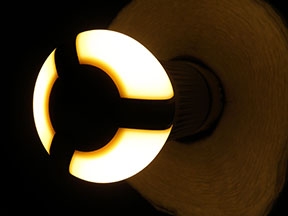A report from Pacific Northwest National Laboratory in Richland, Washington says today’s bulbs made with light-emitting diodes (LEDs) are a bit more friendly to the environment than compact fluorescent lamps (CFLs), but both types of bulbs far outpace traditional incandescent lights. As LED technology advances in the next five years, the environmental advantage for LED bulbs is expected to grow.
LEDs light up when electrons move through a diode, a type of semiconductor, which direct light in a specific direction, sending a small amount of heat back into an aluminum heat sink. CFLs are illuminated by an electric current driven through a tube containing gases, producing ultraviolet light, transformed into visible light by the fluorescent coating on the inside of the tube. An incandescent bulb passes electricity through a metal filament until it become so hot that the filament glows, radiating 90 percent of its energy as heat.
The report examines the total environmental impact, including the energy and natural resources needed to manufacture, transport, operate, and dispose of the three types of light bulbs over their complete life cycles. The authors considered 15 different environmental impacts, including the potential to increase global warming, use land formerly available to wildlife, generate waste, and pollute water, soil and air.
The PNNL team chose specific bulbs representing the most typical and widely available examples for each of the three types of lights, and then used a database to calculate the resources needed to produce the various components of the three light bulbs. LEDs today were found to cause slightly less environmental harm than CFLs in all but one of the 15 environmental variables.
The one exception, where CFLs exceeded LEDs in environmental friendliness, was in generating hazardous waste that must be taken to a landfill. The ribbed aluminum heat sink attached to the bottom of LEDs absorbs and dissipates heat generated by the bulb. The aluminum in the heat sink requires an energy-intensive process to mine and refine, and creates several byproducts such as sulfuric acid that must be disposed as hazardous waste.
Advances in technology are expected to increase the overall advantage for LEDs. Those advances include smaller heat sinks, and thus less aluminum needed for LEDs, as well as other improvements in manufacturing processes and electronics. By 2017, says the report, LEDs should have about half the environmental impacts of today’s models and 70 percent less impact than CFL bulbs, which are not expected to change much over the period.
The analysis indicated, however, both today’s LEDs and CFLs are much more friendly to the environment than traditional incandescent bulbs, which consume far more electricity. PNNL says the incandescent light bulbs they tested consume 60 watts of electricity, while the LED models use 12.5 watts and CFL bulbs use only 15 watts to create the about same amount of light.
Read more:
- University, Company Boost LC Projector Energy Efficiency
- Smart Headlights Help Drivers See Better in the Rain
- LED Process Adapts Ultraviolet Light to Kill Pathogens
- Manufacturing Process Devised for More Economical LEDs
- University Lighting Research Center Gains Industry Backers
* * *


 RSS - Posts
RSS - Posts
[…] LED Bulbs Edge CFLs for Environmental Friendliness […]
[…] LED Bulbs Edge CFLs for Environmental Friendliness […]